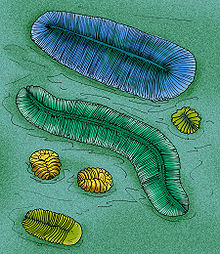Proarticulata
| Proarticulata Temporal range: Ediacaran, around 558–555 Ma |
|
|---|---|
 |
|
| Several Proarticulatans | |
| Scientific classification | |
| Kingdom: | Animalia |
| Phylum: | †Proarticulata Fedonkin, 1985 |
| Class / Family | |
|
|
Proarticulata is an extinct phylum of very early, superficially bilaterally symmetrical animals known from fossils found in the Ediacaran (Vendian) marine deposits, and dates to approximately 558 to 555 million years ago. The name from Greek προ (pro-) = "before" and Articulata, i.e. prior to animals with true segmentation such as annelids and arthropods. This phylum was established by Mikhail A. Fedonkin in 1985 for such animals as Dickinsonia, Vendia, Onega, Praecambridium and currently many other Proarticulata are described (see list).
The transverse articulation (division) of the Proarticulata body into isomers is distinct from the transverse articulation segments in annelids and arthropods, as their individual isomers occupy only half the width of their bodies, and are organized in an alternating pattern along the longitudinal axis of their bodies. In other words, one side is not the direct mirror image of its opposite (chirality). Opposite isomers of left and right side are located with displacement of half of their width. This phenomenon is described as the symmetry of gliding reflection.
The body is completely segmented, with all isomers curved towards the posterior, and the first isomer is normally much larger than the rest. The first two isomers at the anterior dorsal end are partly fused. (e.g., Vendia, Paravendia and Karakhtia).
These proarticulatans demonstrate incomplete segmentation, as the anterior zone is free of isomers, often making a "hairband" like appearance. (example cephalozoans include Yorgia, Praecambridium, Andiva, Archaeaspinus, Ivovicia, Spriggina, Marywadea and Cyanorus. Some cephalozoans from the family Yorgiidae demonstrate pronounced asymmetry of left and right parts of the body. For instance, Yorgia’s initial right isomer is the only one which spreads far towards the left side of the body. Archaeaspinus has an unpaired anterior lobe confined by the furrow to the left side only.
...
Wikipedia
